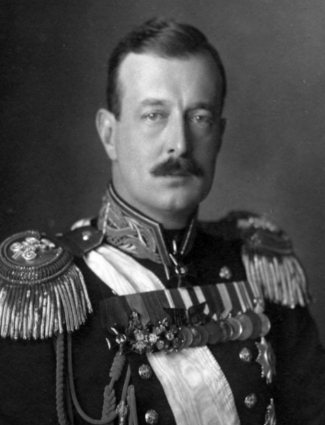Grand Duke Kirill Vladimirovich (Romanov) (1876–1938)

Grand Duke Kirill Vladimirovich (Romanov)
Source
Source
The son of the elder brother of Emperor Alexander III, Grand Duke Vladimir Aleksandrovich, and Grand Duchess Maria Pavlovna was born on October 12, 1876, in Tsarskoye Selo. From his early childhood, Kirill Vladimirovich received a naval education.
He participated in the Russo-Japanese War and was able to survive the explosion of the battleship “Petropavlovsk” on March 31, 1904. In 1905, the young knyaz Kirill Vladimirovich married Victoria Melita, Princess of Great Britain and Ireland and of Saxe-Coburg and Gotha (Victoria Feodorovna).¹ In 1912, the Grand Duke graduated from the Naval Academy. On August 3, 1914, he was sent to the active army to serve in the naval department of Admiral Rusin at the Stavka of the Supreme Commander. In 1917, he served in Murmansk. On March 21, 1917, on the day of the arrest by the Provisional Government of Nicholas II and members of his family, Kirill Vladimirovich resigned from the armed forces.²
From June 1917 to autumn 1919, Grand Duke Kirill Vladimirovich and his family were in Finland, where he contacted General Baron Carl Gustav von Mannerheim and communicated through his representative with General Yudenich. On April 25, 1920, the family of the Grand Duke went through Germany to Switzerland to Zurich. In April 1921, they moved to Cannes.³
He participated in the Russo-Japanese War and was able to survive the explosion of the battleship “Petropavlovsk” on March 31, 1904. In 1905, the young knyaz Kirill Vladimirovich married Victoria Melita, Princess of Great Britain and Ireland and of Saxe-Coburg and Gotha (Victoria Feodorovna).¹ In 1912, the Grand Duke graduated from the Naval Academy. On August 3, 1914, he was sent to the active army to serve in the naval department of Admiral Rusin at the Stavka of the Supreme Commander. In 1917, he served in Murmansk. On March 21, 1917, on the day of the arrest by the Provisional Government of Nicholas II and members of his family, Kirill Vladimirovich resigned from the armed forces.²
From June 1917 to autumn 1919, Grand Duke Kirill Vladimirovich and his family were in Finland, where he contacted General Baron Carl Gustav von Mannerheim and communicated through his representative with General Yudenich. On April 25, 1920, the family of the Grand Duke went through Germany to Switzerland to Zurich. In April 1921, they moved to Cannes.³
On November 21, 1921, Nikolai Markov sent a message to Grand Duke Kirill Vladimirovich, in which he described the main directions of the activity of the new organization, the Supreme Monarchist Council (VMS). On August 8, 1922, the Grand Duke published a message to the Russian people and the Russian Army. It was then that he officially set out to lead the Russian monarchist movement. However, his urges did not receive a positive response either from the Commander-in-Chief of the army, Wrangel, or from the Grand Duke Nikolai Nikolayevich, and the ROVS did not support him.⁴
On September 13, 1924, Kirill Vladimirovich published his manifesto and assumed the title of Custodian of the Russian Imperial Throne. At the same time, the Grand Duke created the Corps of the Imperial Army and Navy in opposition to the ROVS. On November 19, he issued a rescript on the convening of a “Conference on the constitution of Imperial Russia”. In 1926, the Grand Duke moved to Saint-Briac, France, with his family.⁵
In 1931, he took patronage over the officers of the Izmailovsky Regiment. In 1932, the Grand Duke established a connection with the Union of Young Russians and its leader Alexander Lvovich Kazem-Bek. He also maintained contact with the Russian Orthodox Church Abroad. On September 12, 1938, Kirill Vladimirovich died in Coburg.⁶
On September 13, 1924, Kirill Vladimirovich published his manifesto and assumed the title of Custodian of the Russian Imperial Throne. At the same time, the Grand Duke created the Corps of the Imperial Army and Navy in opposition to the ROVS. On November 19, he issued a rescript on the convening of a “Conference on the constitution of Imperial Russia”. In 1926, the Grand Duke moved to Saint-Briac, France, with his family.⁵
In 1931, he took patronage over the officers of the Izmailovsky Regiment. In 1932, the Grand Duke established a connection with the Union of Young Russians and its leader Alexander Lvovich Kazem-Bek. He also maintained contact with the Russian Orthodox Church Abroad. On September 12, 1938, Kirill Vladimirovich died in Coburg.⁶

Content Oriented Web
Make great presentations, longreads, and landing pages, as well as photo stories, blogs, lookbooks, and all other kinds of content oriented projects.
[1] Nemirovich-Danchenko, Kirill. ‘Kirill I Vladimirovich, Gosudar’ Imperator Vserossiyskiy v izgnanii 1876-1938’. ‘Rossiyskoye Monarkhicheskoye Dvizheniye’ informatsionnyy byulleten’, no. 40 (November 2006). http://monarhia.ru/img/01/2006/09-14/40.pdf.
[2] Chuvardin, German. ‘Velikiye knyaz’ya Romanovy “v izgnanii”: problema politicheskoy samoidentifikatsii’. Uchenyye zapiski Orlovskogo gosudarstvennogo universiteta, no. 1(82) (2019): 76–80.
[3] Zakatov, Aleksandr. ‘Stanovleniye dinastii Romanovykh v izgnanii’. Istoricheskiy vestnik 3 (2013): 208–53.
[4] Dumin, Stanislav. Romanovy. Imperatorskiy dom v izgnanii. Moskva: Zakharov-AST, 1998
[5] Seregin, Aleksandr. ‘“Belyye monarkhisty” russkoy emigratsii 1920-kh gg’. Obshchestvo: filosofiya, istoriya, kul’tura, no. 7(51) (2018). https://doi.org/https://doi.org/10.24158/fik.2018.7.8.
[6] Graf, Garal’d. Na sluzhbe Imperatorskomu Domu Rossii. 1917—1941: Vospominaniya. Sankt-Peterburg, 2004.
[2] Chuvardin, German. ‘Velikiye knyaz’ya Romanovy “v izgnanii”: problema politicheskoy samoidentifikatsii’. Uchenyye zapiski Orlovskogo gosudarstvennogo universiteta, no. 1(82) (2019): 76–80.
[3] Zakatov, Aleksandr. ‘Stanovleniye dinastii Romanovykh v izgnanii’. Istoricheskiy vestnik 3 (2013): 208–53.
[4] Dumin, Stanislav. Romanovy. Imperatorskiy dom v izgnanii. Moskva: Zakharov-AST, 1998
[5] Seregin, Aleksandr. ‘“Belyye monarkhisty” russkoy emigratsii 1920-kh gg’. Obshchestvo: filosofiya, istoriya, kul’tura, no. 7(51) (2018). https://doi.org/https://doi.org/10.24158/fik.2018.7.8.
[6] Graf, Garal’d. Na sluzhbe Imperatorskomu Domu Rossii. 1917—1941: Vospominaniya. Sankt-Peterburg, 2004.